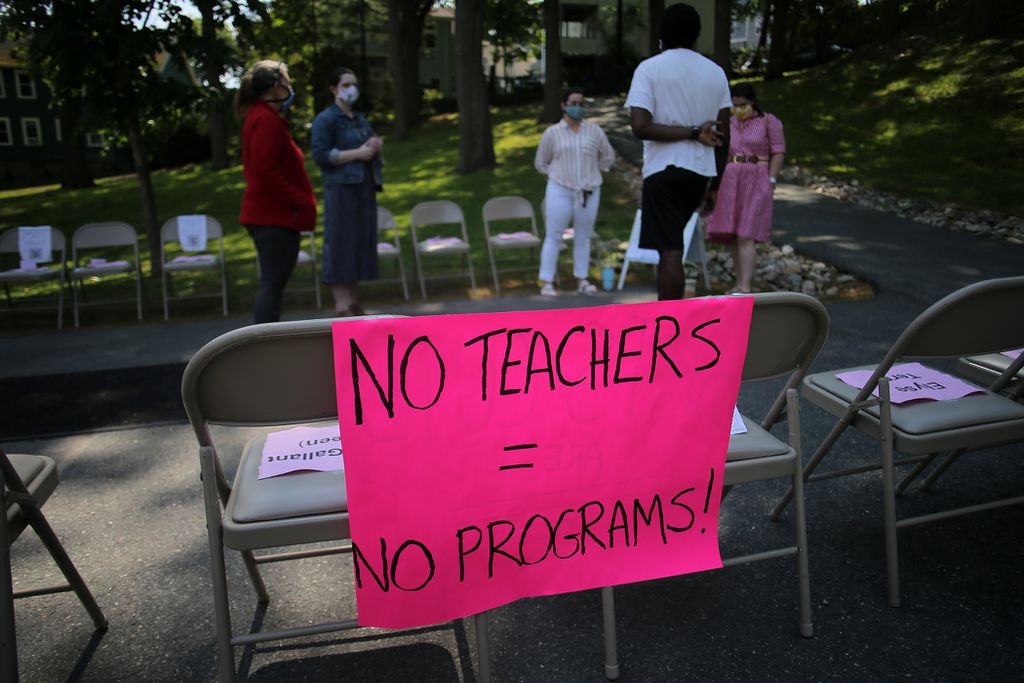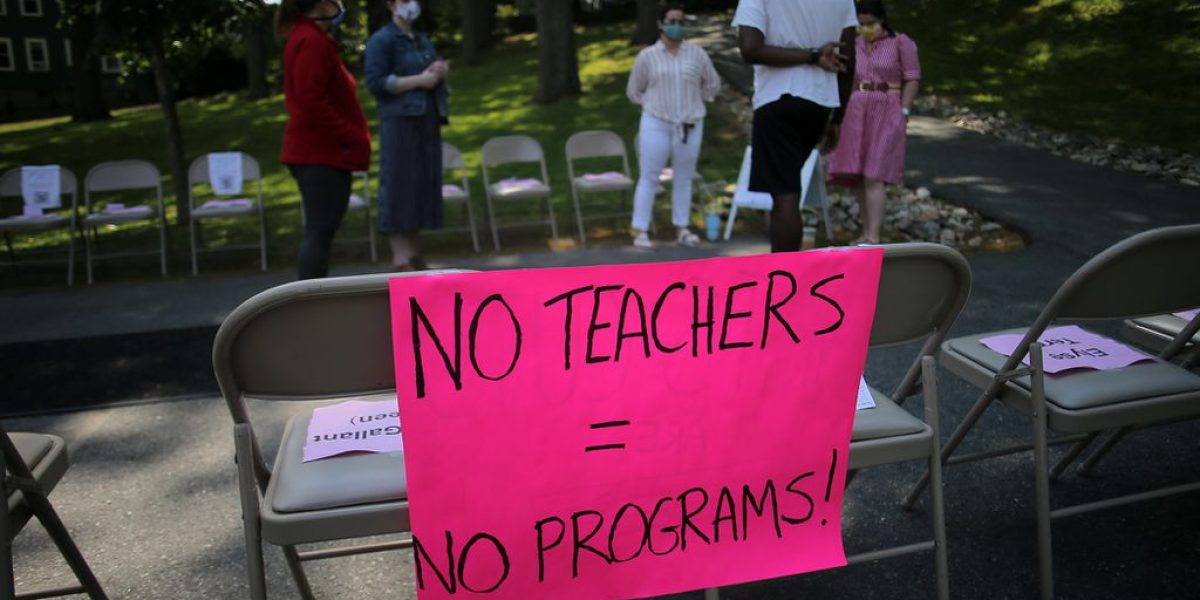
Layoff notifications in Randolph, Brookline, and other school districts spark concerns
THE BOSTON GLOBE – Public school teachers and staff across Massachusetts are bracing for the most extensive school layoffs the state has seen in years as districts begin handing out pink slips to reduce costs in the face of possible deep budget cuts.
School officials in affluent Brookline sent shock waves across the state recently when union officials said the district notified more than 360 educators that their last day would be June 23, though school officials later said they will rescind many of the notices. School officials in Randolph and Fairhaven have also confirmed sending layoff notices to more than 50 educators combined.
And the Massachusetts Teachers Association said that, based on reports from its membership, dozens of school districts have quietly sent layoff notices to staff, though it could not immediately identify which districts. More could be coming soon as many schools face a June 15 deadline to notify junior staff members whose jobs are in jeopardy.
The financial hardship also threatens to undermine the state’s heralded school reform initiative that was supposed to bring millions to struggling districts. Now many are just hoping to stay above water.
“We are bracing for thousands of cuts,’’ said Merrie Najimy, president of the Massachusetts Teachers Association.
Najimy said she’s especially worried about the impact of cuts on low-income students whose education has been most disrupted by the pandemic. If anything, schools need increased resources to prepare for smaller classes and increased supports for students, advocates say.
“Deep cuts at this moment are going to be devastating to public education,’’ Najimy added. “You can’t reopen on a shoestring budget.”
The layoff notices so far appear to affect mostly teachers in specialized subject areas such as arts, music, and physical education, although school counselors, social workers, and paraprofessionals are affected, union officials said.
In Brookline, the notices sent out in late May exacerbated an already contentious relationship between educators, the superintendent’s administration, and School Committee, said Jessica Wender-Shubow, president of Brookline Educators Union, triggering days of local protests.
“This was blunt, cutting to the bone,” she said. “It was based on no knowledge whatsoever of what the union could have done if [the district] had bothered to work with us as partners.”
By Friday afternoon, it appeared the situation was easing. Interim Superintendent Ben Lummis sent a statement to colleagues that Brookline could probably reverse many of the layoffs. He said the School Committee had agreed to a budget for next school year “that allows us to move quickly to rescind many of the layoff notices that were issued one week ago.”
Pink slips for educators are not uncommon in the spring. Under state law, teachers with less than three years experience must be notified by June 15 whether their positions will be cut. But some municipalities, including Brookline and Randolph, have negotiated earlier deadlines for informing teachers about potential layoffs.
Not every district is planning on sending out layoff notices just yet. While Brockton schools officials said they intend to send out “reduction in force” notices this Friday, Worcester, Newton, and Andover superintendents said they plan to preserve their staff. Boston officials, meanwhile, said they did not expect an unusual number of teachers to receive layoff notifications.
Widespread teacher layoffs would be particularly jarring this year, coming as schools begin to plan for what is likely to be a historically challenging fall.
Across the state, superintendents have expressed frustration that they will be needing more, not fewer, resources and staff to operate. They will likely face increased transportation costs and the need to equip their staff with the proper protective gear and resources to adjust to a new classroom environment.
But there is little doubt that cities and towns across the Commonwealth will have fewer dollars to work with in the next school year. The Massachusetts Taxpayer Foundation is predicting a $6 billion drop in state tax revenues in fiscal year 2021, which could force cuts in state aid to education. With local tax revenues declining as well, virtually every district is putting together some range of options, including their worst case scenarios. Some superintendents said they may not know until August what their budgets might be.
Tom Scott, executive director of the Massachusetts Association of School Superintendents, said members of the group have been preparing for various scenarios, including the possibility of reductions of 10 to 20 percent in their budgets this fall.
“I certainly hear the word layoffs,” he said. “The frustration is not knowing what that budget will be or how damaging this could be to the programs and services that they want to offer.”
Fairhaven Superintendent Robert Baldwin said his district recently sent out more than a dozen layoff notices to educators, including arts, math, and science teachers.
“I am planning for the worst case scenario,” he said, adding that if it turns out the district is able to get adequate funding from the state, he will likely bring some of those positions back.
Uncertainty also looms over the state’s heralded Student Opportunity Act, which is supposed to infuse more than $1 billion to the poorest school districts over a seven-year period. Now some are wondering whether the state can afford this year’s proposed $355 million in new spending related to the landmark education legislation.
“If we do not get significant federal funding, I worry that the first year funding that we had anticipated may be jeopardized,” said state Representative Alice Peisch, cochair of the joint Committee on Education.
“Unless something dramatic takes place, I don’t know how the state meets that commitment,” added Ed Lambert, executive director of the Massachusetts Business Alliance for Educators who also pushed for the Student Opportunity Act
The pandemic struck at the start of the legislative review process of Governor Charlie Baker’s proposed $44.6 billion spending plan, which was filed in late January. Normally, the House votes in April and the Senate in May, followed by a conference committee to resolve any differences. But the pandemic put the budget season on pause, leaving state funding for education unresolved.
The committee is in talks with the Baker administration on how to proceed, but it is highly unlikely that a full budget will be determined before the fiscal year ends June 30, said state Representative Aaron Michlewitz, cochair of the Joint Ways and Means Committee.
In the meantime, municipalities are holding budget hearings without firm information on state aid. Some areas, stung by local tax revenue losses after major business shutdowns, are already making cuts.
In Randolph, a town hit hard by the pandemic, outrage erupted after more than 40 educators recently were informed their positions will not be renewed in the fall. They include 23 arts, music, and physical education teachers, six classroom aides, two instructional coaches, and a speech and language pathologist, said Shauna Rommelmeyer, president of the Randolph Education Association who is also a first grade teacher.
Six guidance counselor and five social worker positions were trimmed for budget reasons, she said.
“Our students right now have a lot of social-emotional needs coming off of COVID, and they are going to be coming back to school with more [of these issues] not less,’’ Rommelmeyer said.
The decision follows the furlough of a separate group of 91 classroom aides in May, she said, in another blow to the district.
Superintendent Thea Stovell did not respond to requests for comments, but in a letter to the Randolph school community dated June 1, she said the reductions are both for budgetary and operational reasons.
”Districts across the state are facing severe budget reductions based upon predictions of potential reductions to local aid of 10-20 [percent], and we here in Randolph are not immune,” she wrote.
The layoff notices were steeper in Brookline. The town was facing a $12 million deficit, caused by plummeting local revenues from excise, meal, and commercial taxes, said the town’s Select Board Chairman Bernard Greene.
“These are the things that are really hurting us,’’ said Greene, who expects more layoffs in other districts as June 15 nears.
“We are not any worse than any other community,” Greene said. “Everyone is subject to this financial collapse.”
Teachers in Brookline protesting outside Heath Elementary School last Wednesday said the notices reflected a deep betrayal and conveyed the message that they were expendable.
“I came from Boston public schools where pink slipping was somewhat of a norm,” said Kelly Gallant, one of more the two dozen teachers at the school who got pink slips. “I came to Brookline where I knew education was really important. … So when this happened, it was just really devastating.”
The decision also sparked protests outside Town Hall and other school buildings, and at a virtual School Committee hearing Thursday last week.
Lummis, the interim superintendent, explained the layoffs in a letter to the school community, saying the town budget is “under extreme stress” due to the economic crisis caused by the COVID-19 pandemic.
By Friday, amid a public outcry, district officials had a change of heart, saying that they had agreed on a budget that would allow them to avoid many of the layoffs.
In a statement, Lummis said the budget outlook for the school district has been dire, forcing “us to consider painful cuts across the school district.”
However, he added, “After careful deliberation and by listening to the outpouring of community concern,” he wrote, “the School Committee took steps last [Thursday] night to bridge the budget shortfall.”
By Meghan E. Irons
Members of Support the Students of Randolph advocacy group have organized in its mission to support the eliminated teachers and staff, the whole education of Randolph’s students, with a goal of reversing the decisions of the district. To learn more about Support the Students of Randolph’s advocacy initiatives, visit the Facebook group at facebook.com/groups/SupportTheStudentsOfRPS/ or visit its website at supportrandolphstudents.com.

Public relations and media administration services provided to the Support the Students of Randolph initiative as a Michelle McGrath PR advocacy project.







